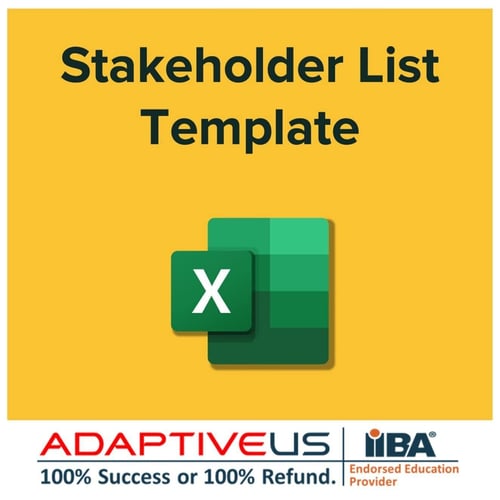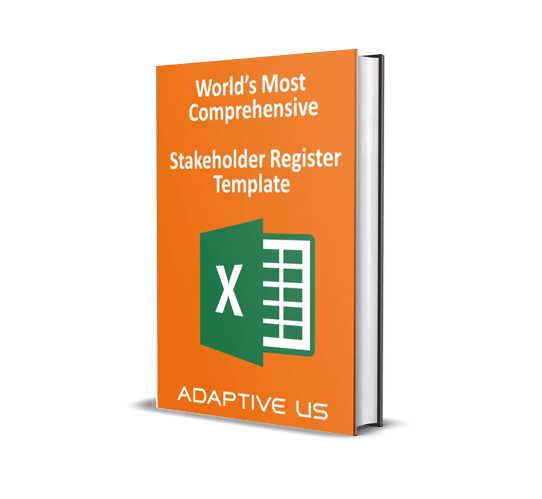How to Plan Stakeholder Engagement : Industry Best Practices
As a business analyst, you understand the critical role stakeholders play in the success of any project. Engaging and collaborating with stakeholders is essential to ensure their needs are met, expectations are managed, and project objectives are achieved. In this article, we will explore the key elements of planning stakeholder engagement and how they can contribute to the overall success of your projects. So let's dive in and discover how you can effectively plan stakeholder engagement using proven techniques and tools from the Business Analyst Body of Knowledge (BABoK). Are you ready? Let's get started!
What are stakeholders?
Stakeholders are individuals or groups with a vested interest in the outcome of a project. They can be internal or external to an organization and include employees, customers, suppliers, shareholders, regulatory bodies, and even the general public. Essentially, anyone affected by or who influences the project is considered a stakeholder.
What are stakeholder Types?
Now let's delve into the different types of stakeholders that you may encounter during your projects. First up are primary stakeholders – these are individuals or groups directly impacted by the project and have a significant influence on its success. For example, key decision-makers within your organization would fall under this category.
Next, we have secondary stakeholders – individuals or groups who may not have direct involvement in the project but can still be influenced by its outcomes. This could include competitors, industry associations, or advocacy groups.
Another type of stakeholder is known as latent stakeholders – these individuals or groups may become relevant at some point during the project but currently do not play an active role. It's essential to keep them in mind as their needs might arise later.
There are negative stakeholders – these are individuals or groups who oppose the project and may actively work against it. Understanding their concerns and finding ways to address them is crucial for successful stakeholder engagement.
By identifying and classifying stakeholders based on their level of impact and influence on your projects, you can tailor your engagement approach to ensure effective communication and collaboration throughout all stages of implementation.
Identifying and classifying stakeholders
Identifying and classifying stakeholders is crucial in planning stakeholder engagement for effective project implementation. Stakeholders are individuals, groups, or organizations that have an interest or influence in the project's outcome. They can be internal or external to the organization.
To effectively engage with stakeholders, it is essential to identify and classify them based on their level of involvement and impact on the project. This helps in understanding their needs, expectations, and potential risks they might pose.
The classification of stakeholders can vary depending on the nature of the project but commonly includes categories such as primary stakeholders (those directly affected by the project), secondary stakeholders (those indirectly affected), key decision-makers, influencers, users/customers, suppliers/vendors, regulatory bodies, and community groups.
Businesses can prioritize their engagement efforts by identifying and classifying stakeholders early in the planning process. This ensures that resources are allocated efficiently and that communication strategies are tailored to meet each stakeholder's specific needs.
Effective stakeholder engagement involves keeping track of each stakeholder's interests, concerns, preferences, and level of support toward the project. This information allows businesses to develop appropriate strategies for engaging with different types of stakeholders throughout various stages of the project lifecycle.
In summary, stakeholder identification and classification play a vital role in successful stakeholder engagement planning.
This approach enables businesses to understand better who they need to involve, Influence, and communicate with during every phase of a project.
Without proper identification and classification, it becomes challenging to accurately assess stakeholders' needs and expectations, which can ultimately impact the overall success of a given project.
Hence, business analysts should utilize appropriate tools and techniques from the field to identify, classify, and analyze various stakeholders for an effective stakeholder engagement approach.

Purpose of planning stakeholder engagement
Effective stakeholder engagement is crucial for the successful implementation of any project. The purpose of planning stakeholder engagement is to ensure that the right stakeholders are identified, their needs and expectations are understood, and appropriate strategies are put in place to engage with them throughout the project lifecycle.
One key purpose of planning stakeholder engagement is to build positive relationships with stakeholders. By understanding their interests, concerns, and goals, project teams can tailor communication and collaboration efforts to meet their specific needs. This helps foster trust and support from stakeholders, increasing the likelihood of project success.
Another important purpose is to gather valuable input from stakeholders. Organizations can tap into their expertise and insights by involving them early in the planning phase. This enables better decision-making and ensures that potential risks or issues are addressed proactively.
Additionally, planning stakeholder engagement allows organizations to manage conflicts effectively. By identifying potential areas of disagreement or competing priorities among stakeholders upfront, project teams can develop strategies for resolution or compromise. This facilitates smoother communication and minimizes disruptions during project execution.
The purpose of planning stakeholder engagement is to create a collaborative environment where all relevant parties feel heard and included in the decision-making process. It sets a foundation for effective communication channels, mutual understanding, and shared ownership to drive project success.
Factors Affecting the Planning of Stakeholder Engagement
The success of any project relies heavily on effective stakeholder engagement. However, planning for stakeholder engagement is not a one-size-fits-all approach. Several factors can impact the planning process and ultimately determine its success.
One key factor to consider is the level of influence and importance that each stakeholder holds. This will help prioritize their involvement and ensure their needs are addressed accordingly. Additionally, considering stakeholders' attitudes towards the project can help determine how best to engage with them.
Another factor to take into account is the availability of resources. Adequate time, budget, and personnel must be allocated to plan and execute stakeholder engagement activities effectively. Without sufficient resources, engaging stakeholders in a meaningful way may be challenging.
The project's complexity also plays a significant role in planning for stakeholder engagement. Projects involving multiple stakeholders or those with high levels of uncertainty require more careful consideration when developing an engagement strategy.
External factors such as legal requirements or industry regulations should also be considered during the planning phase. Compliance with these external factors can significantly shape how stakeholders are engaged throughout the project lifecycle.
Organizational culture and dynamics can impact stakeholder engagement efforts. Understanding internal politics and power dynamics within an organization helps identify potential challenges or barriers during implementation.
By taking these factors into account during the planning phase, business analysts can develop a comprehensive stakeholder engagement strategy tailored to meet specific project needs, ultimately leading to successful outcomes.
Inputs required to start planning stakeholder engagement
Inputs required to start planning stakeholder engagement vary depending on the project and its specific stakeholders. However, some common inputs can help kickstart this important process.
It is crucial to gather information about the project itself. This includes understanding its objectives, scope, and expected outcomes. Without a clear business analysis approach, it becomes challenging to identify relevant stakeholders and plan meaningful engagement activities.
Knowledge about the organization's structure and culture is essential. Understanding how decisions are made and how power dynamics influence stakeholder relationships will inform the approach taken in engaging with different individuals or groups.
Additionally, conducting a thorough stakeholder analysis is vital for effective planning. This involves identifying all potential stakeholders related to the project and assessing their level of influence, interest, and potential impact on the outcome. This analysis helps prioritize resources and tailor engagement strategies accordingly.
Furthermore, input from subject matter experts can provide valuable insights into specific stakeholder groups or industries impacted by the project. Their expertise contributes to developing targeted communication plans that speak directly to stakeholders' concerns or interests.
Utilizing tools such as surveys or interviews can help gather direct feedback from stakeholders themselves. These inputs offer first-hand perspectives on expectations, concerns, or suggestions for effective engagement approaches.
Business analysts can develop well-informed strategies that foster collaboration and support successful project implementation by considering these inputs at the outset of planning stakeholder engagement efforts.
Performing stakeholders analysis
Performing a stakeholder analysis is a crucial step in planning stakeholder engagement for effective project implementation. This process involves identifying and assessing the individuals or groups who have an interest or influence over the project. By conducting a thorough stakeholders analysis, Business Analysts can gain valuable insights into their needs, expectations, and potential impact on the project.
During this analysis, it is essential to identify both internal and external stakeholders. Internal stakeholders may include project team members, management, and employees directly impacted by the project. External stakeholders can be customers, suppliers, regulatory authorities, or community groups that may be affected by the project's outcomes.
Once identified, stakeholders should be classified based on their level of influence and interest in the project. This classification helps prioritize engagement efforts and ensures resources are allocated effectively.
Business Analysts use various techniques to gather information about stakeholders, such as interviews, surveys, workshops, etc. These techniques provide a deeper understanding of stakeholder perspectives enabling better decision-making during stakeholder engagement planning.
The information gathered from stakeholder analysis helps in defining appropriate strategies for collaboration with different stakeholder groups. It also assists in determining communication needs tailored to each group's requirements.
By performing a comprehensive stakeholders analysis early in the planning process, Business Analysts can effectively plan to engage with key individuals or groups throughout the project lifecycle.
Defining stakeholder collaboration
Defining stakeholder collaboration is crucial in planning stakeholder engagement for effective project implementation. Collaboration involves actively involving stakeholders in the decision-making process, ensuring their input and feedback are considered throughout the project lifecycle.
Stakeholder collaboration goes beyond simply informing or consulting stakeholders; it aims to create a mutually beneficial relationship where stakeholders feel valued and empowered. This collaborative approach fosters trust, encourages open communication, and promotes transparency among all parties involved.
To define stakeholder collaboration, Business Analysts must determine the level of involvement required from each stakeholder group. This can range from passive participation to active collaboration, depending on the nature of the project and its impact on different stakeholders.
Collaboration methods may include workshops, focus groups, interviews, or online forums to gather insights and ideas from stakeholders. It is essential to establish clear objectives for these collaborative activities to ensure they align with project goals and deliver tangible outcomes.
By defining stakeholder collaboration early in the planning process, Business Analysts can set expectations with stakeholders regarding their role in decision-making processes. This helps build trust and ensures that all relevant perspectives are considered when making critical decisions.
Defining stakeholder collaboration means establishing clear guidelines for engaging with stakeholders throughout a project. By fostering collaborative relationships built on trust and open communication channels, businesses can leverage valuable insights from their diverse range of stakeholders to drive successful project implementation.
Deciding Stakeholder Communication Needs
When it comes to effective project implementation, communication plays a crucial role in ensuring that stakeholders are well-informed and engaged throughout the process. Deciding on stakeholder communication needs is an important step in planning stakeholder engagement.
To begin with, it is essential to identify your stakeholders and understand their unique characteristics and requirements. This will help you tailor your communication approach accordingly. For example, different stakeholders may have varying levels of knowledge or interest in the project, so you need to determine how much information they require and at what frequency.
Another factor to consider is the preferred mode of communication for each stakeholder group. Some individuals might prefer face-to-face meetings or phone calls, while others might be more responsive to emails or online platforms. Understanding these preferences ensures your messages reach the right people through the most effective channels.
Additionally, considering the level of detail needed by each stakeholder group is crucial. While some groups may require high-level summaries and updates on progress, others may need more detailed reports or technical documentation. By tailoring your communications based on their specific needs, you can keep them engaged and informed without overwhelming them with unnecessary information.
Furthermore, timing plays a vital role in deciding stakeholder communication needs. Ensure that your communications frequency aligns with key milestones or decision points within the project timeline. Regular updates will help stakeholders stay connected and provide valuable input when needed.
In conclusion
Organizations can foster collaboration and maintain strong relationships with all parties involved by carefully deciding stakeholder communication needs as part of planning stakeholder engagement in projects. Effective communication ensures that stakeholders feel heard and valued throughout every stage of a project's life cycle - from initiation to closure. By investing time upfront into understanding their preferences and requirements regarding information dissemination channels, content depth, and frequency, you pave the way for successful collaboration and supportive feedback loops and ultimately achieve better outcomes for everyone involved.
Tools for planning stakeholder engagement
Planning stakeholder engagement is a crucial aspect of project implementation, and as a Business Analyst, having the right tools, like a stakeholder map, at your disposal can greatly enhance this process. Several tools are specifically designed to help plan stakeholder engagement and ensure effective communication throughout the project lifecycle.
One such tool is the Stakeholder Engagement Matrix. This matrix helps identify stakeholders based on the project's level of influence and interest. By mapping stakeholders onto this matrix, you can prioritize your efforts and focus on engaging those with strong influence or interest.
Another useful tool is the Stakeholder Register, which allows you to document key information about each stakeholder, including their role, contact details, expectations, and potential risks or issues they may pose to the project. This information is a valuable reference when developing strategies for engaging stakeholders effectively.

Additionally, Communication Plans can be created using various software applications that assist in defining how and when communication will occur with different stakeholders. These plans outline specific channels of communication (such as email updates or regular meetings) tailored to meet each stakeholder's needs.
Furthermore, Business Analysis Modeling Tools like mind maps or flowcharts can also aid in visualizing stakeholder relationships, collaboration requirements, and decision-making processes involved during stakeholder engagement planning.
These models provide a clear overview of complex interactions among stakeholders, enabling better decision-making regarding resource allocation and communication strategies.
In conclusion, using appropriate Business Analyst tools greatly facilitates planning for successful stakeholder engagement.
These tools empower Business Analysts to identify stakeholders efficiently, classify them according to their relevance, prioritize collaboration activities, and develop effective communication strategies.
All these contribute towards building stronger relationships between all parties involved, fostering cooperation, and ultimately leading to successful project implementation.
Techniques for planning stakeholder engagement
Business Analyst techniques are crucial in planning stakeholder engagement for effective project implementation. These techniques help the business analyst gather and analyze information about stakeholders, their needs, and their expectations. By using these techniques, the business analyst can tailor the stakeholder engagement approach to ensure maximum collaboration and communication.
One useful technique is conducting interviews with key stakeholders. This allows the business analyst to directly engage with stakeholders to understand their perspectives, concerns, and goals. Through these interviews, valuable insights can be gained into what each stakeholder expects from the project.
Another technique is facilitating workshops or focus groups. These sessions bring together multiple stakeholders in a collaborative setting where ideas are shared and discussed openly. It helps identify common interests among stakeholders and promotes consensus-building.
In addition to interviews and workshops, surveys or questionnaires can also be used to gather stakeholder input. These tools allow for data collection on a larger scale while still capturing individual perspectives.
Data analysis techniques such as SWOT (Strengths, Weaknesses, Opportunities, Threats) analysis or PESTLE (Political, Economic, Social, Cultural, Technological, Legal, Environmental) analysis can also aid in identifying potential risks or opportunities related to stakeholder engagement.
One important technique is creating visual representations of stakeholder relationships through tools like influence mapping or power-interest grids. These visuals provide clarity on who holds influence within the organization and how they may impact decision-making processes.
By employing these various Business Analyst techniques during the planning phase of stakeholder engagement activities, knowledge area experts will have better insight into how best to engage with different types of stakeholders based on their specific needs.
While many other BABoK-endorsed methods are available, the ones mentioned above serve as fundamental starting points that enable successful project implementation through effective stakeholder management.
Outputs of Stakeholder Engagement Approach
The stakeholder engagement approach is about planning and executing strategies and aims to generate valuable outputs. These outputs play a crucial role in ensuring the success of project implementation. Let's dive into some key outputs resulting from effective stakeholder engagement.
Enhanced Stakeholder Relationships:
By actively involving stakeholders in the decision-making process and addressing their concerns, you can foster stronger relationships with them. This increases trust, collaboration, and support throughout the project lifecycle.
Clear Communication Channels:
A well-planned stakeholder engagement approach establishes clear communication channels between all relevant parties involved in a project. This ensures that information flows smoothly, allowing stakeholders to stay informed and engaged at every stage.
Mitigated Risks:
Through continuous dialogue with stakeholders, potential risks and issues can be identified early on, and appropriate measures can be taken to mitigate them effectively. By proactively managing risks, you minimize disruptions during project execution.
Improved Decision-Making:
Effective stakeholder engagement facilitates gathering diverse perspectives from various stakeholders who may have different expertise or experiences related to the project domain. This allows for more comprehensive discussions leading to better-informed decision-making.
Successful Project Adoption:
When stakeholders are involved from the beginning stages of a project and their needs are considered throughout its lifecycle, there is a higher likelihood of successful adoption by end-users or customers.
Increased Project Success Rate:
These positive outcomes contribute towards achieving overall project success - meeting objectives within budgetary constraints while delivering value as per stakeholders' expectations.
In conclusion:
The outputs resulting from an effective stakeholder engagement approach go beyond just accomplishing tasks; they create lasting relationships, facilitate transparent communication channels, mitigate risks early on, improve decision-making processes, and ultimately increase the chances of overall project success.
Conclusion
In today's dynamic business environment, stakeholder engagement is crucial for successfully implementing projects. Organizations can gain valuable insights, address concerns, and ensure project success by understanding and involving the right stakeholders.
Business analysts play a vital role in effectively planning stakeholder engagement by utilizing various tools and techniques outlined in the Business Analysis Body of Knowledge (BABoK). They identify and classify stakeholders based on their level of influence and interest in the project. This helps determine how to engage with each stakeholder group.
Organizational culture, project complexity, and industry regulations must also be considered when planning stakeholder engagement. These factors shape the approach taken to engage stakeholders throughout the project lifecycle.
Performing a thorough stakeholder analysis allows businesses to understand each stakeholder's goals, attitudes, expectations, and potential impact on the project. This analysis informs decision-making processes and ensures stakeholders' needs are addressed effectively.
Defining collaboration strategies with stakeholders is essential for fostering effective communication channels. By establishing clear lines of communication early on in a project, organizations can minimize misunderstandings or conflicts that may arise later.
Business analyst tools such as RACI charts (Responsible-Accountable-Consulted-Informed) help define roles and responsibilities within stakeholder engagement activities. Additionally, interviews or surveys enable gathering valuable input from stakeholders regarding their preferences for communication methods or frequency.
The outputs of an effective stakeholder engagement approach include increased support from key stakeholders throughout all project stages. It leads to improved decision-making processes by better understanding various viewpoints while ensuring alignment with organizational objectives.
By recognizing that every individual or group involved has specific interests at stake during a project's implementation phase – whether they are internal employees or external partners – organizations can develop tailored approaches for engaging them proactively.
Ultimately successful planning for stakeholder engagement requires continuous evaluation and adjustment throughout any given initiative's life cycle. Hence, it helps to not only meet current needs but also anticipate future challenges.
You May Also Like
These Related Stories

Planning Business Analysis Information Management

Requirements Analysis: Drilling Down to the Details


No Comments Yet
Let us know what you think